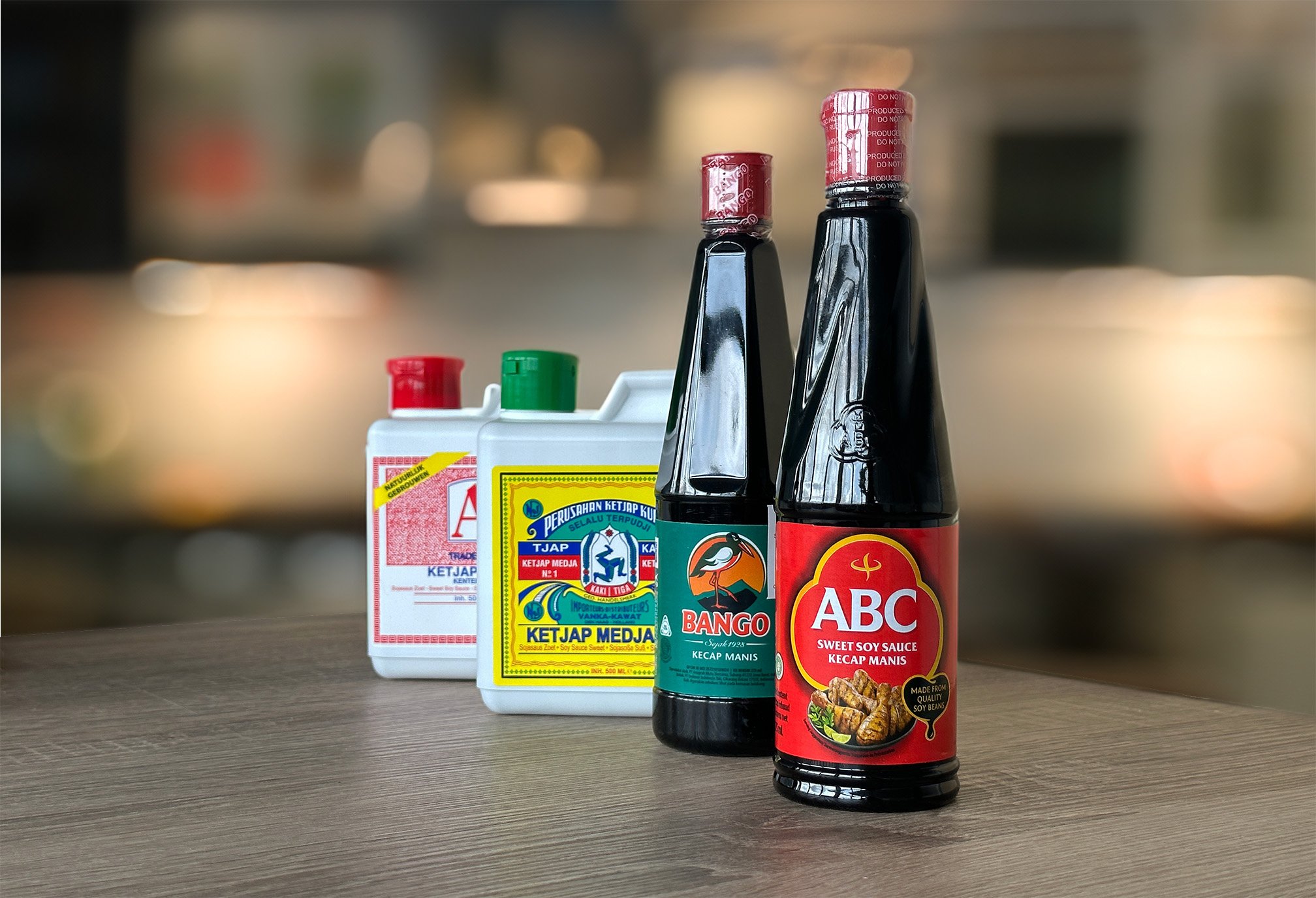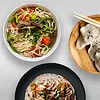Don't know which soy sauce you need? That's understandable, as there are countless options! It is one of the most popular condiments in the world and essential in Asian cuisine. In this blog, we'll tell you everything about this unique condiment and share a few alternatives with youl. Keep reading so you never have to wonder which soy sauce you need again.
Shop your favorite soy sauce!
What is soy sauce?
The history of soy sauce can be traced back to ancient China, where salt was used to preserve vegetables, fruits, meats, and fish. Over time, the Chinese added soybeans and wheat to this sauce, resulting in the soy sauce we love today. The sauce made its way to Japan, where it quickly became a common flavoring for Japanese dishes like sushi. Many other countries followed and now there are versions from Indonesia, Thailand, the Philippines, Korea, and more countries. Later in this blog, we'll dive deeper into the different types of soy sauce so keep reading.
How is soy sauce made?
There are many different types of soy sauce, so the exact process varies by region and recipe. However, in general, making soy sauce is a complex and time-consuming process that requires specific skills. The key part of the production process is fermenting the soy sauce as this greatly influences its quality. Fermentation can be done in two ways: naturally or chemically, and we'll explain the difference below.
Naturally brewed
Naturally brewed soy sauce is the traditional type and can also be called artisanal soy sauce. It is made through a natural fermentation process that can take months or even years. Naturally brewed soy sauce often consists of water, soybeans, wheat, salt, and sometimes a fungus called koji. Koji is a special mold used in the brewing of Japanese soy sauce. This soy sauce is a high-quality sauce with a rich and complex flavor.
Chemically brewed
The chemical brewing process is much faster and requires less effort, usually completed within weeks or months. It is a more automated process that involves using chemicals to alter the structure of soybeans and wheat. The resulting liquid is then further neutralized and flavored with salt and other additives. Although the chemical brewing of soy sauce is less time-consuming, it also yields a sauce with a less rich and complex flavor compared to naturally brewed soy sauce.
How do you know if soy sauce is naturally brewed?
If you want a high-quality soy sauce with a rich and complex flavor, naturally brewed soy sauce is the best choice. But how can you be sure if your soy sauce is naturally brewed? The first thing you can do is check the list of ingredients. Naturally brewed soy sauce is made only from soybeans, wheat, salt and water, while chemically brewed soy sauce contains other chemical additives. Price is also a good indicator since the complex production process makes naturally brewed soy sauce more expensive.
Types of soy sauce
We've talked about the origin and production of soy sauce, but what about the different types? Below, we'll list some of the most popular types of soy sauce by region, explain the differences and tell you how you can use them.
Chinese soy sauce
There are two main types of Chinese soy sauce which are a light soy sauce and a dark soy sauce. They differ by texture, colour and taste. Find out more about the differences below.
- Light soy sauce: this soy sauce is the most common type of soy sauce. It is made from soybeans, wheat and salt and has a thin, watery consistency. Light soy sauce is the most versatile soy sauce out there. This the one you can use for stir-fries, marinades and dipping sauces. You could say it’s an all-purpose soy sauce that can be used for anything.
- Dark soy sauce: the dark soy sauce is mostly used for coloring. It’s thicker, darker and a bit more sweet because of the sweetener that is added while brewing it. Sometimes it can be used for stir-fries dishes as well, but mostly it’s mixed with light soy sauce in a ratio of 1-part dark soy sauce to 2 or 3 parts of light soy sauce. Dark soy sauce is thicker, less salty, has a richer flavor profile and is a bit more sweet than light soy sauce.
Shop Chinese sojasaus!
Japanese soy sauce
Japanese soy sauce, also known as shoyu, is made from soybeans, wheat, and an additional ingredient called koji. Koji is a type of mold from the Aspergillus Oryzae family and is particularly used to initiate the fermentation process of soy sauce. It imparts a unique flavor that is characteristic of Japanese soy sauce. This sauce can be used in a variety of Japanese dishes and is also a staple table condiment. Below, you will find the five most important types of Japanese soy sauce:
- Dark soy sauce, or Koikuchi: This is the most popular type of Japanese soy sauce and is made from wheat and soybeans. The most well-known Kikuchi soy sauce is that of Kikkoman, but there are also special variations. For example, consider the Koikuchi Shoyu soy sauce from Umami Paris. This soy sauce is of premium quality and is specially made in Japan. It is fermented for a year in special fermentation vats, resulting in a truly unique and rich umami flavor.
- Light soy sauce, or Usukuchi has a milder flavor and lighter color than Koikuchi due to the use of amazake, a sweet fermented rice. Additionally, a significant amount of salt is used, causing this soy sauce to ferment for a shorter period and have a slightly saltier taste. This soy sauce is best used for dishes where you're seeking a more subtle umami flavor.
- Shiro shoyu: Characteristic of this type of soy sauce is its light color. This is because it's made with more wheat and fewer soybeans. It's a white soy sauce primarily used as a finishing touch and offers a unique, mild, and salty flavor.
- Genen shoyu: This is soy sauce with reduced salt content. It is made by fermenting Koikuchi soy sauce again, resulting in a significantly lower salt concentration. This soy sauce is perfect for people who want to consume less salt.
- Marudaizu shoyu: This soy sauce is also known as whole bean soy sauce because it is exclusively made with whole soybeans. It has a slightly milder but complex flavor compared to Koikuchi soy sauce and is often used for sushi and sashimi.
In addition to the regular Japanese soy sauces, Japan also has ponzu. This is a combination of soy sauce, citrus fruit juice, and dashi broth. Ponzu has a rich umami flavor with a refreshing touch. It is a fantastic ingredient to incorporate into salad dressings, for example.
We have a wide range of premium Japanese soy sauces. Check them out and discover their unique characteristics.
Japanese soy sauces.
Korean soy sauce
Korean soy sauce, known as ganjang, is made from fermented soybeans, wheat, and salt. It has a rich, complex flavor and is used in many Korean dishes such as stews, soups, and marinades. There are four basic types of ganjang, and below we explain how to use the different types.
- Yangjio ganjang: This is a naturally brewed soy sauce made from soybeans and rice, barley, or wheat. It is the least salty Korean soy sauce and also the most expensive. Typically, this type is used to season vegetables or served on the table as a condiment.
- Hansik ganjang: Also known as guk ganjang or Joseon ganjang, this is a naturally brewed Korean soy sauce traditionally used to flavor soups. For example, it is used to make Kimchi Jiggae, a Korean soup dish with pork, tofu, and vegetables.
- Sanbunhae ganjang: This is a chemically brewed soy sauce often used to give dishes a deeper umami flavor. You can use it to marinate meat, fish, or vegetables, or as a flavor enhancer in soups and stews. It is sometimes used to enhance broths and sauces as well. A well-known dish that uses Sanbunhae ganjang is the Korean rice dish bibimbap.
- Jin ganjang: By far the most popular type of Korean soy sauce. It is a mix of naturally brewed Jin ganjang and chemically brewed Sanbunhae ganjang. With this sauce, you can make dishes such as Japchae, a famous Korean noodle dish, or Bulgogi, a Korean beef dish.
Shop Korean soy sauce!
Thai soy sauce
Thai soy sauce shares many similarities with other soy sauces such as Chinese and Japanese varieties. There are four main types of Thai soy sauce: light soy sauce, mushroom light soy sauce, dark soy sauce, and sweet soy sauce. They are all used to create the perfect balance of flavors. Below, we will explain the differences between the types of Thai soy sauce.
- Thai light soy sauce: This is the most common type of Thai soy sauce and can be used in most Thai dishes. It has a salty, slightly sweet flavor that is perfect for stir-fries, marinades, and dipping sauces.
- Thai dark soy sauce: Similar to Chinese dark soy sauce, it is slightly thicker and has a darker color than the light version. However, unlike the Chinese version, Thai dark soy sauce has a sweeter taste due to the addition of palm sugar. It is often used to give dishes a darker color and a sweet flavor.
- Thai mushroom soy sauce: This is a light soy sauce with the addition of mushroom extract as an ingredient. If you enjoy a rich umami flavor with a hint of mushrooms, this is an excellent choice. You can use it in the same way as regular Thai light soy sauce, such as in dipping sauces, marinades, or noodle dishes.
Thai sweet soy sauce: As the name suggests, this soy sauce is the sweetest of them all. In terms of texture, it is similar to Thai dark soy sauce, but the taste is different because it has a higher amount of palm sugar added to it. It is a thicker, sweeter soy sauce that is perfect for stir-fries and noodles
Shop Thai soy sauce!
Filipino soy sauce
You may also know Filipino soy sauce as Toyo. This soy sauce is primarily used in the Philippines for dishes such as adobo, sinigang, and pancit. It is a thin soy sauce with a saltier taste than what you're accustomed to with other soy sauces. In addition to regular Filipino soy sauce, there are two other variants:
- Toyomansi: this soy sauce is made with calamansi, which is a type of lime that grows in the Philippines. Due to the use of this lime, it can remind you of Japanese ponzu sauce.
- Toyo at suka: this is soy sauce with vinegar. It is commonly used in dishes with grilled meat, fish balls, Chinese dumplings, and steamed fish.
Shop Philippine soy sauce!
Indonesian soy sauce
Indonesian soy sauce, also known as kecap, is made from soybeans, palm sugar, and a blend of spices. This soy sauce differs significantly from other types of soy sauce, particularly in terms of texture and taste. The texture is thicker, and the sauce has a sweeter and more savory flavor. It is widely used in Indonesian dishes, marinades, and dipping sauces to enhance both the flavor and color. For example, you can find it in nasi goreng as a flavor enhancer for the rice or as part of the marinade for satay.
Shop Indonesian kecap!
Indonesian soy sauces.
Alternatives to soy sauce
There are several alternatives that can replace soy sauce in your favorite dishes. This is useful if you're allergic to soy or have a gluten intolerance. These are worthy products that can very well substitute the taste of soy.
Tamari
Tamari is a soy sauce made without wheat, making it gluten-free. Its taste is slightly less intense than traditional soy sauces, but it is a good alternative for those who want to eat gluten-free. In terms of texture, tamari is most similar to light soy sauce.
Coconut Aminos
As the name suggests, coconut aminos is made from coconut. This sauce has a sweet taste and is free from gluten and soy. Moreover, it contains less sodium, making it a great and healthy alternative to regular soy sauces.
How to store soy sauce?
After purchasing your favorite soy sauce, it's best to store it in a cool, dry place away from direct sunlight. Once opened, you can keep it in the refrigerator to extend its shelf life and maintain the quality of its taste.
Conclusion
Soy sauce is a popular and flavorful ingredient that can be used in various dishes and cuisines. There are also plenty of alternatives for people who don't eat soy or have a gluten intolerance. Each type of soy sauce has its own characteristics and flavor profile, but regardless of the type, this condiment adds a rich umami taste to all your dishes.




 New Arrivals
New Arrivals
 Outlet
Outlet
 Search by country
Search by country
 Search per category
Search per category
 Holiday Season
Holiday Season
 Recipes
Recipes
 Tjin's Blog
Tjin's Blog









